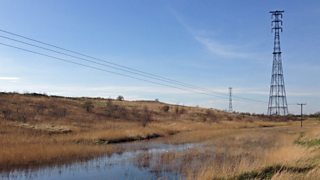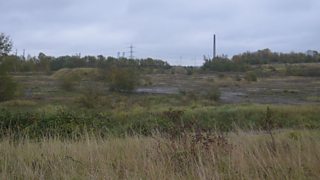Paul Hetherington from Buglife shares sentiments on a remarkable site for a whole variety of reasons.

It’s a misty early autumn morning arriving at the Botany Marshes entrance to Swanscombe Marshes opposite the Cemex plant. It hardly sounds the ideal place to look for wildlife, but first perceptions can be deceptive. Down from the raised road descending into Great Expectations for this must be how Dickens saw this area when writing of Pip and Abel Magwitch. The Swanscombe Peninsula juts sharply into the River Thames from the Kent shoreline, just downriver from the QEII Bridge.
To the south, chalk cliffs stare starkly out across the marsh and grazing land like a mini Dover though these are human hewn from once gentle chalk hills a by-product of the first British Cement works active 1825 until 1990. Indeed, much of this area owes it abundant wildlife to those cement works, waste from the plant was dumped across the nearby marshes creating dips and rising, bare ground, scrub and even woodland a perfect open mosaic habitat. It is in this pock marked landscape that most of the really rare wildlife thrives. The hawthorn is throbbing with berries it is going to be a mast year here.

The marshlands of Swanscombe, Botany and the saltmarsh of Broadness are home to an amazing recorded 83 different breeding species of bird but this rare open mosaic habitat the legacy of industrialisation sports common lizards a plenty plus almost 2,000 species of invertebrate including n incredible250 of conservation concern. Earlier in the year the site was buzzing with Sea aster mining bees and brown banded carder bees but as the year plays out even that most eminent of invertebrates the (Attulus distinguendus) is hard to spot thriving in beds of clinker and rubble one of our rarest spiders known to just this site and West Thurrock Marshes coincidentally across the national grid power lines in Essex.
A short walk around the circular path and grazing cattle can be spied another remnant of yesteryear when much of the peninsula was saltmarsh and wet grazing pasture, home to a remote farm and a few sheepfolds.

Walking on despite the now driving rain and into view comes the tallest electric pylon in the British Isles, suspending cables across the Thames and a reward for this wet walk as an osprey swoops down from its regular perch aloft the pylon to hunt on the marshes below.
Past the pylon there is a really good view across the open mosaic habitats so much bare ground ideal for bugs and reptiles to warm up for the day in the suns glow, though sadly not today as the rain persists. A little further around the path and ahead can be seen new Thameside flats to the left more reedbeds and open lagoons fringed by maturing trees and to the right the embankment of a flood defence.

A climb to the top of this flood defence reveals a view across the Thames and below and old abandoned jetty that once served the Swanscombe cement works. Looking landward now across the marshes you can spy the remnants of the pylons that carried and aerial transport to take goods across the marshes to and from the cement works. The area around this abandoned jetty is one of our smallest Marine Conservation Zones the domain of the rare Tentacled lagoon worm. It is also from these wharfs that the Mulberry harbours were set afloat bound for D-day cemented down the pylons adjacent to the marshes where a nearby park marks the finding of the earliest hominid remains from the British Isles.
The rain persists, so it is time to leave this jewel of the Thames. This former industrial site is currently being ear-marked for a theme park, the London Resort, but I, for one, would be very sad indeed to lose what I see as already being a resort and resource steeped in history, literature, archaeology and wildlife a plenty.
